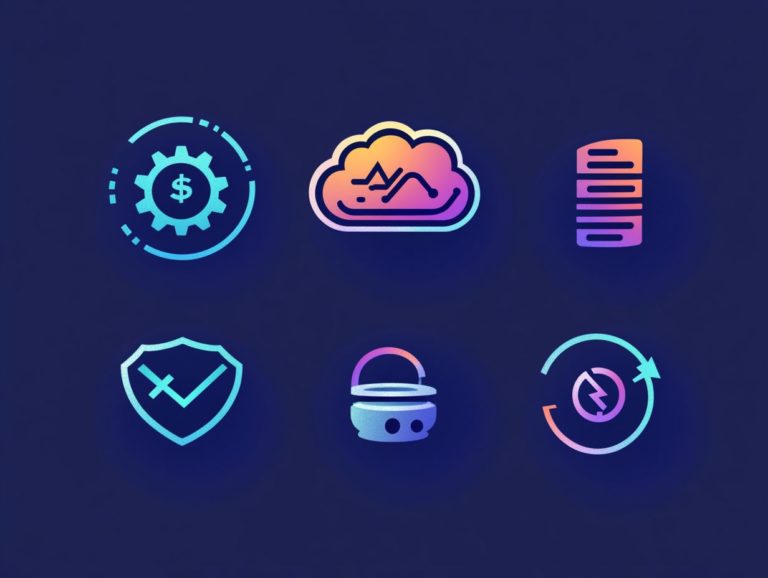5 IaaS Performance Monitoring Tools
In today s fast-paced digital landscape, ensuring optimal performance of IaaS (Infrastructure as a Service) is vital for effectively leveraging the cloud. This article delves into five leading IaaS performance monitoring tools: SolarWinds Server & Application Monitor, Dynatrace, New Relic, Datadog, and AppDynamics.
You ll explore the significance of performance monitoring, key features to consider, common challenges, and best practices. Whether you re aiming to optimize costs, enhance scalability, or bolster security, this guide will equip you with the insights necessary for making informed decisions.
Contents
- Key Takeaways:
- 1. SolarWinds Server & Application Monitor
- 2. Dynatrace
- 3. New Relic
- 4. Datadog
- 5. AppDynamics
- What Is IaaS Performance Monitoring?
- Why Is IaaS Performance Monitoring Important?
- What Are the Key Features to Look for in an IaaS Performance Monitoring Tool?
- How Can IaaS Performance Monitoring Tools Help with Cost Optimization?
- What Are the Common Challenges in IaaS Performance Monitoring?
- What Are the Advantages and Disadvantages of Using IaaS Performance Monitoring Tools?
- How Can a Business Choose the Right IaaS Performance Monitoring Tool for Their Needs?
- What Are the Best Practices for IaaS Performance Monitoring?
- How Can IaaS Performance Monitoring Tools Help with Scalability?
- What Are the Future Trends in IaaS Performance Monitoring?
- How Can Infrastructure as a Service (IaaS) Performance Monitoring Tools Help with Security?
- What Are the Different Types of IaaS Performance Monitoring Tools Available?
- How Can IaaS Performance Monitoring Tools Help with Disaster Recovery?
- What Are the Costs Associated with IaaS Performance Monitoring Tools?
- How Can IaaS Performance Monitoring Tools Help with Resource Allocation?
- Frequently Asked Questions
- What are 5 IaaS Performance Monitoring Tools?
- What is Nagios XI?
- How does SolarWinds Orion help with IaaS performance monitoring?
- What makes Zabbix a popular choice for IaaS performance monitoring?
- How does Datadog stand out among other IaaS performance monitoring tools?
- What Makes Dynatrace Stand Out in Performance Monitoring?
Key Takeaways:
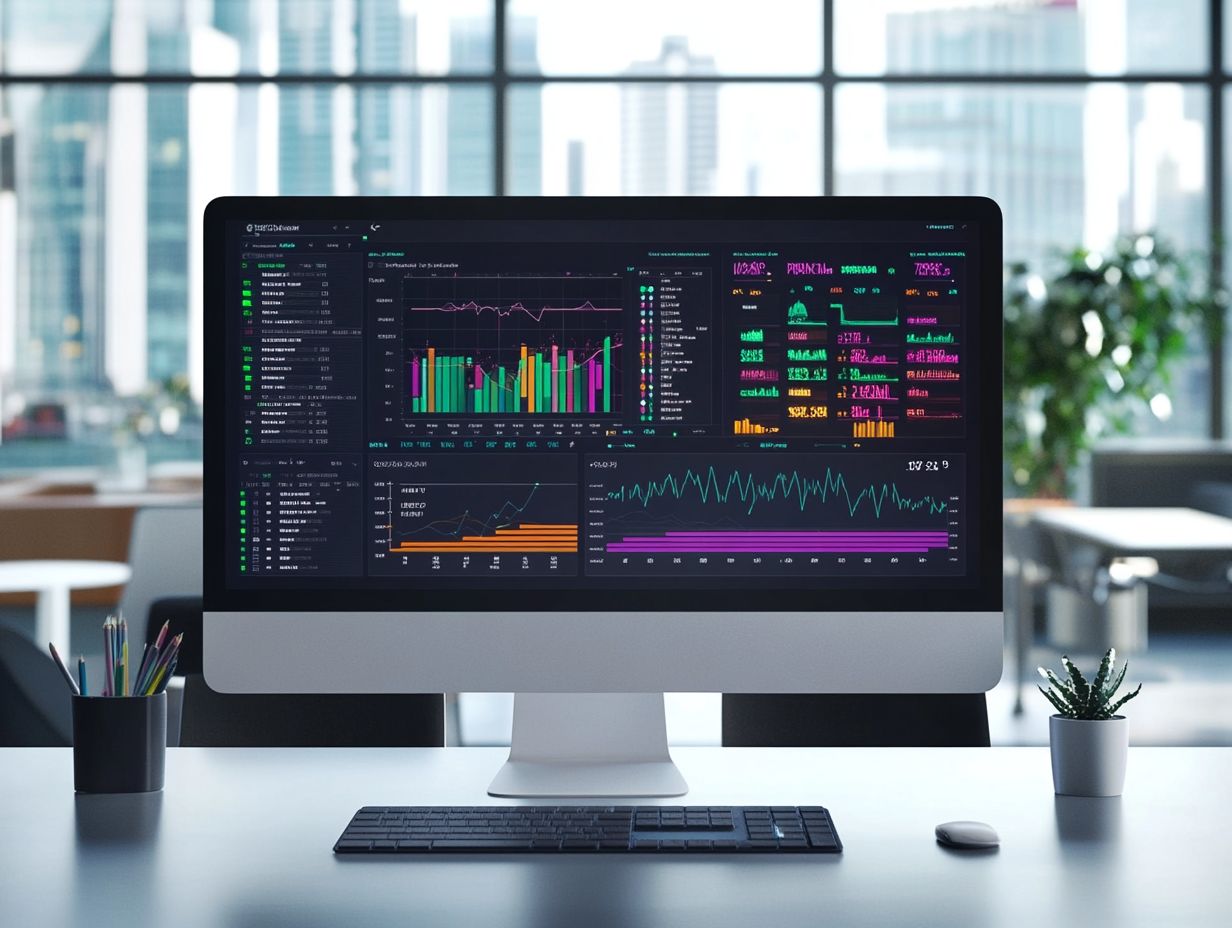
Stay on top of your IaaS performance with these top tools: SolarWinds, Dynatrace, New Relic, Datadog, and AppDynamics. IaaS performance monitoring is crucial for optimizing costs, ensuring scalability and security, and disaster recovery. To effectively evaluate your cloud performance, review the 5 key metrics for evaluating cloud performance when choosing a monitoring tool, considering key features and best practices for maximum effectiveness.
1. SolarWinds Server & Application Monitor
SolarWinds Server & Application Monitor is a powerful Application Performance Monitoring (APM) tool designed to elevate your user experience. It delivers real-time insights into application performance metrics, monitoring systems across hybrid and cloud environments.
This tool features an intuitive dashboard that gathers essential information, making it easy for your team to evaluate the health of applications and their dependencies. By integrating with collaborative development and operations, it helps you quickly identify and resolve performance bottlenecks, boosting overall efficiency.
Compared to other APM solutions, SolarWinds excels with advanced features like network performance monitoring and detailed application dependency mapping. This allows you to pinpoint issues across complex systems with precision.
Its performance optimization capabilities enable you to anticipate potential problems before they affect users, ensuring smoother and more reliable service delivery.
2. Dynatrace
Dynatrace is your go-to advanced application performance monitoring solution that harnesses AI for actionable performance insights. With this tool, you can optimize application delivery and significantly enhance the overall user experience.
What truly sets this innovative platform apart is its automated root cause analysis, enabling teams to pinpoint and resolve performance issues quickly. By integrating intelligent problem detection, Dynatrace minimizes downtime and boosts application reliability in real-time.
Its seamless integration with cloud environments allows efficient monitoring and management of your applications, regardless of your deployment strategy.
The sophisticated monitoring dashboards provide a comprehensive view of performance metrics, simplifying alignment between development and operational practices, ultimately driving superior business outcomes.
3. New Relic
New Relic stands as a premier performance monitoring tool, offering comprehensive insights into application behavior. This enables your organization to identify performance metrics and health indicators that directly influence user experience.
With powerful monitoring alerts, you can swiftly address issues before they escalate, ensuring uninterrupted services. New Relic’s log management features allow easy aggregation and analysis of logs, providing a clearer understanding of system activities and potential bottlenecks.
This level of detail is essential for effective performance diagnostics, enabling you to manage incidents with precision and quickly identify the root causes of downtime. Whether operating in cloud or hybrid environments, New Relic excels at delivering actionable data, helping your team optimize applications and enhance overall operational efficiency.
4. Datadog
Datadog is a powerful application performance monitoring (APM) tool that offers a unified view of infrastructure performance and application metrics. This allows your DevOps team to swiftly detect anomalies and resolve performance issues.
What sets this platform apart is its seamless integration with a variety of SaaS solutions. This enables you to gather insights across diverse tools and environments.
Its real-time data visualization capabilities enhance your monitoring, making it easier to grasp complex metrics at a glance.
Datadog excels in tracking application dependencies by providing crucial data on how different services interact. This is essential for effective troubleshooting.
Whether deployed in a cloud setting or on-premise, its versatility ensures that your organization can maintain optimal performance and embrace a proactive approach to system management.
5. AppDynamics
AppDynamics is a top application performance monitoring tool that offers profound insights into transaction performance. This enables you to proactively address performance issues and enhance the user experience.
What truly differentiates it from other APM tools is its unwavering focus on business applications. This feature allows your teams to align technical performance metrics with overarching business outcomes seamlessly.
You ll benefit from advanced monitoring capabilities that provide real-time analytics. This enables you to understand how applications function and their impact on overall business efficiency.
AppDynamics excels in tracking application topology and behavior. It gives you the ability to visualize changes and dependencies instantly, which is vital for pinpointing root causes and refining the application lifecycle. This ultimately fosters an agile response to any potential disruptions.
What Is IaaS Performance Monitoring?
IaaS performance monitoring is the process of tracking and analyzing the performance of Infrastructure as a Service (IaaS) environments. It focuses on various aspects of your application stack performance to ensure everything operates optimally for an excellent user experience.
This practice involves identifying bottlenecks, assessing resource utilization, and monitoring cloud service performance. In the rapidly evolving landscape of cloud technologies, effective performance monitoring is critical now more than ever. It helps maintain the availability, reliability, and efficiency of your applications.
Utilizing a variety of monitoring tools ranging from traditional APM solutions to cloud-native platforms and third-party integrations is crucial for gathering valuable insights. Key metrics include:
- CPU usage: Indicates how much processing power your applications are consuming.
- Memory allocation: Shows how much memory each process is using.
- Network bandwidth: Measures the amount of data transmitted over your network.
- Response times: Reflects how quickly your applications respond to user requests.
These metrics are critical for diagnosing issues and ensuring your underlying infrastructure can handle dynamic workload demands.
Why Is IaaS Performance Monitoring Important?
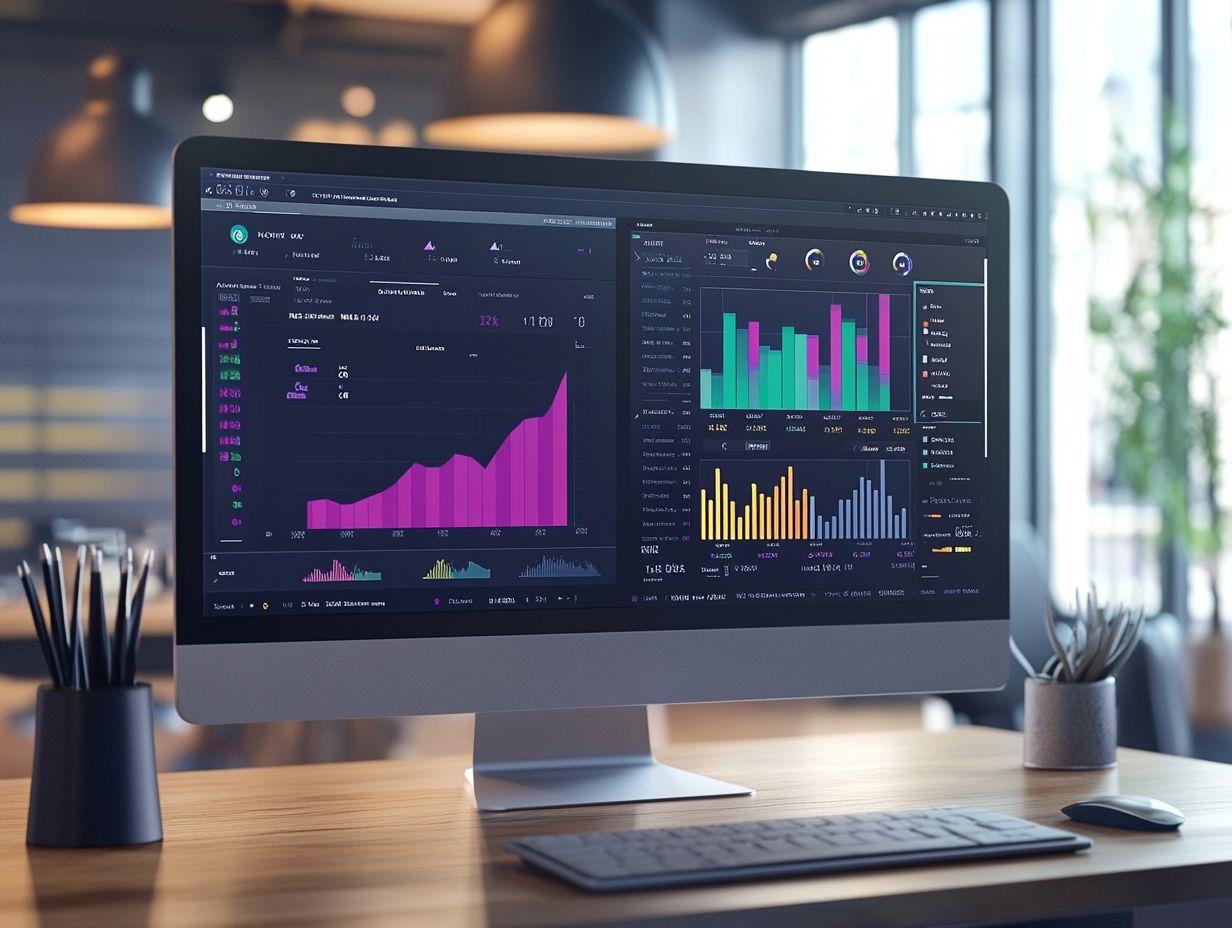
IaaS performance monitoring is essential for boosting your organization s performance and cutting costs while ensuring an exceptional user experience and efficient resource management.
With real-time insights into system performance and resource utilization, you can make informed decisions about scaling and provisioning. For example, a leading e-commerce company adopted IaaS performance monitoring and swiftly identified bottlenecks during peak shopping seasons. This proactive strategy slashed error rates by 30% and enabled them to allocate resources on the fly, responding to demand as it unfolded.
As a result, user satisfaction soared, with customers enjoying faster loading times and fewer transaction failures. The healthcare sector has seen similar triumphs, where data-driven insights from performance monitoring have streamlined operations and significantly enhanced patient experiences.
To take full advantage of these benefits, actively adopt these monitoring strategies in your organization for improved real-time engagement and decision-making.
What Are the Key Features to Look for in an IaaS Performance Monitoring Tool?
When selecting an IaaS performance monitoring tool, keep an eye out for key features like real-time monitoring, detailed performance metrics, and customizable alerts. Understanding how to monitor cloud performance is crucial for quick incident management.
Spot unusual patterns early with effective anomaly detection. This prevents small issues from turning into bigger problems. Incorporate data visualization tools to turn complex data sets into easy-to-understand formats. This enables swift assessments of performance trends and resource usage.
Seamless integration with your existing monitoring systems enhances your infrastructure management. It consolidates data streams and ensures coherence across platforms. Together, these features help you maintain optimal performance and significantly improve proactive problem-solving.
How Can IaaS Performance Monitoring Tools Help with Cost Optimization?
IaaS performance monitoring tools can be your secret weapon for cost optimization. They offer insights into performance metrics that reveal inefficient resource allocation and unnecessary spending.
Use these tools to easily find resources you aren’t using fully. This helps you make the most of your budget. For example, a tech startup discovered certain instances were idle during peak hours. By reallocating workloads more effectively, they saved thousands.
A mid-sized retail company improved its checkout application efficiency by monitoring server performance closely. This led to reduced downtime during busy shopping periods.
These scenarios show how performance monitoring can translate into strategic cost savings and enhance your operational efficiency.
What Are the Common Challenges in IaaS Performance Monitoring?
IaaS performance monitoring can be challenging. Common issues include complicated app dependencies and performance problems across distributed environments.
Many organizations struggle to achieve transparency in their cloud infrastructure. This leads to visibility gaps that delay responses to performance degradation. In today’s multi-cloud landscape, your monitoring tools must integrate seamlessly across diverse platforms for a cohesive view.
To tackle these challenges, implement advanced monitoring tools equipped with real-time analytics. Embrace best practices, like defining clear operational guidelines and using automated alerting systems. Regular training for your IT team can significantly enhance efficiency and help you overcome these obstacles.
What Are the Advantages and Disadvantages of Using IaaS Performance Monitoring Tools?
Using IaaS performance monitoring tools offers distinct advantages, such as enhanced visibility into application performance and the ability to quickly identify issues. However, be aware of potential downsides, including costs and the complexity of setup.
While these tools can elevate user experience by providing real-time insights, associated expenses can add up especially for organizations on tight budgets.
Integrating these tools with existing systems can present challenges, potentially leading to downtime or disruptions during the transition.
To navigate these complexities, evaluate your specific needs and make informed decisions. Consider factors like scalability, ease of use, and the level of support provided. A thorough assessment ensures that the chosen solution aligns with your operational goals and financial constraints.
How Can a Business Choose the Right IaaS Performance Monitoring Tool for Their Needs?
Choosing the right Infrastructure as a Service (IaaS) performance monitoring tool requires careful evaluation. To make an informed decision, it’s essential to evaluate IaaS performance metrics and compare different tools to see which one offers the best performance analytics.
Start by gaining a clear understanding of your organization s current demands and future growth plans. Consider factors like scalability to ensure the solution you choose can evolve alongside your infrastructure.
Next, dive into the features offered by different tools. Pay close attention to aspects like automation, real-time analytics, and integration capabilities. Don t overlook cost; balance your budget with functionalities that will genuinely benefit your operations.
Finally, evaluating the level of customer support from the vendor can significantly impact your tool’s effectiveness. This support helps you stay aligned with your monitoring objectives and adapt to your evolving needs.
What Are the Best Practices for IaaS Performance Monitoring?
Best practices for IaaS performance monitoring include establishing clear performance thresholds. Use automated tools and regularly review data to ensure optimal application delivery.
To craft an effective monitoring strategy, start by defining metrics that align with your specific applications and workloads. This step determines acceptable performance ranges and alerts your teams when thresholds are breached.
Leveraging monitoring dashboards grants real-time insights, enabling your teams to visualize performance trends and swiftly identify potential issues.
Stay ahead by keeping up with the latest monitoring features and tools available in the market. These enhancements significantly boost your capacity to track infrastructure health and optimize resource usage effectively.
How Can IaaS Performance Monitoring Tools Help with Scalability?
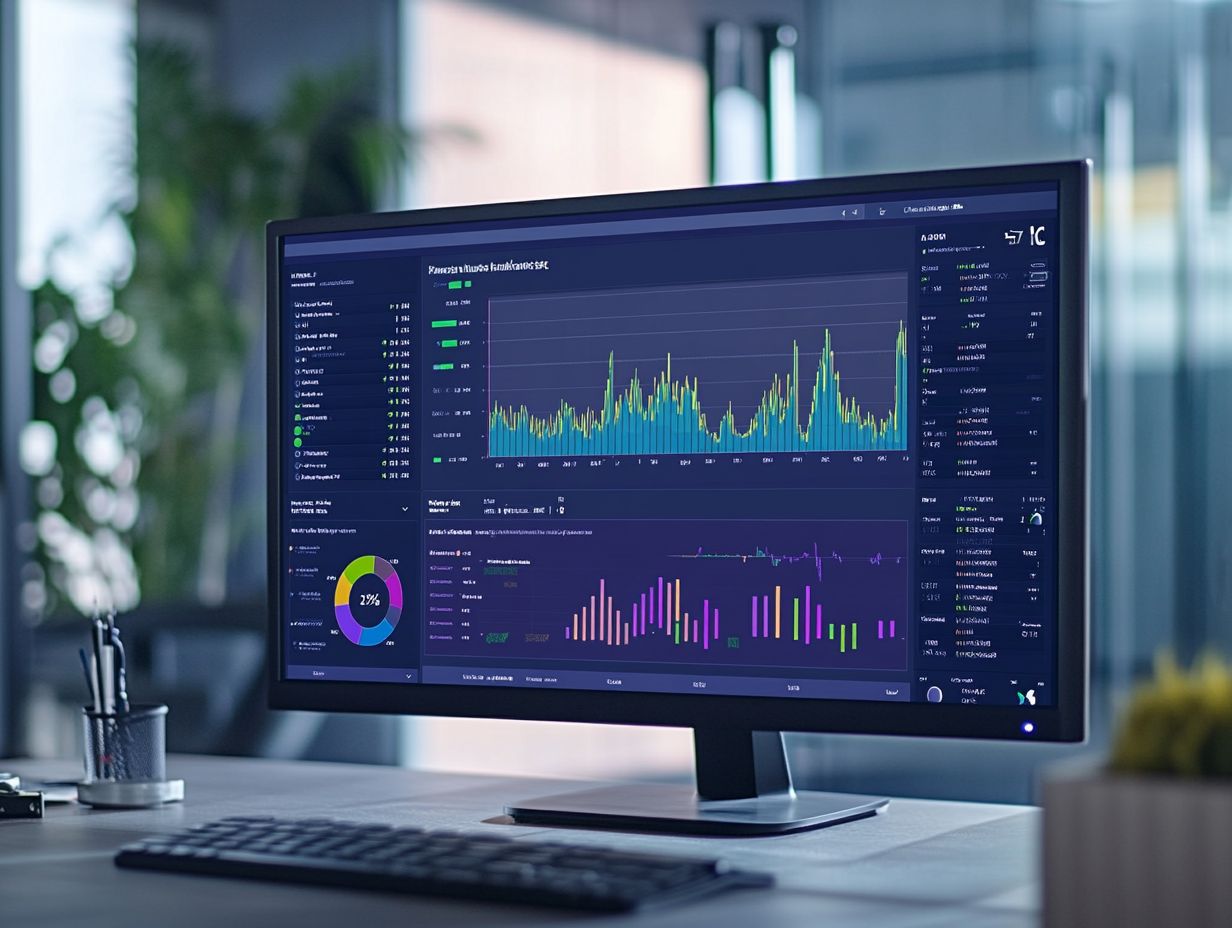
IaaS performance monitoring tools help your business adapt smoothly to changing demands by offering insights into application performance and infrastructure resource utilization, and they can also assist in understanding tools to monitor cloud costs.
By consistently tracking key metrics like CPU utilization, memory consumption, and network latency, these tools allow you to foresee potential bottlenecks and address them proactively.
As you gather performance insights, strategically allocate resources to ensure your systems remain responsive during peak demand periods while avoiding unnecessary costs during quieter times.
This adaptable approach optimizes operational efficiency and fosters your business’s long-term growth, equipping you to respond swiftly to changes in user activity or market conditions, ultimately enhancing your overall service delivery.
What Are the Future Trends in IaaS Performance Monitoring?
The future of IaaS performance monitoring is shaping up to be remarkable, marked by trends like increased automation, sophisticated AI-driven monitoring solutions, and a heightened focus on real-time data visualization.
These advancements will not only boost efficiency but also help you identify potential issues before they escalate into major problems. With machine learning algorithms, you ll analyze vast amounts of data and extract actionable insights quickly.
As you continue to embrace cloud technology, embracing these advanced tools now is crucial for staying competitive. Ultimately, prioritizing these trends in your monitoring strategies positions you to optimize your infrastructure and elevate overall performance.
How Can Infrastructure as a Service (IaaS) Performance Monitoring Tools Help with Security?
IaaS performance monitoring tools are crucial allies in enhancing security. They help pinpoint performance issues that could signal vulnerabilities or breaches within cloud environments, and using the right tools to monitor cloud migration progress can further strengthen these efforts.
By continuously tracking system behavior, these tools enable you to detect anomalies that stray from typical usage patterns. This capability allows you to respond swiftly to potential incidents before they escalate into significant threats.
Alerts from unusual activity give timely warnings, enabling your security team to investigate and act on potential breaches with agility. The integration of performance monitoring with security practices establishes a comprehensive framework, ensuring that both system efficiency and security measures work in harmony.
This synergy not only streamlines your responses to threats but also fortifies overall operational resilience.
What Are the Different Types of IaaS Performance Monitoring Tools Available?
You’ll find a variety of IaaS performance monitoring tools on the market, each designed with distinct features and functionalities to meet your monitoring needs and organizational objectives. To effectively assess these tools, consider reviewing the key metrics to evaluate IaaS performance.
For example, infrastructure monitoring tools focus on the health and performance of your underlying systems and networks. They ensure resources are optimized and downtime is kept to a minimum.
Conversely, application performance monitoring tools track the responsiveness and stability of your software applications, which is crucial for maintaining customer satisfaction.
If your organization operates in hybrid environments, you can take advantage of specialized solutions that seamlessly blend both on-premises and cloud infrastructure. This gives you a comprehensive view of performance.
By understanding your specific business requirements, you can select the right monitoring tool, ultimately enabling your company to boost operational efficiency and deliver an exceptional user experience.
How Can IaaS Performance Monitoring Tools Help with Disaster Recovery?
IaaS performance monitoring tools can play a pivotal role in your disaster recovery efforts. They offer critical performance metrics and insights that shape recovery strategies and reduce downtime.
By harnessing these monitoring solutions, you can collect essential data on system performance and resource utilization across your infrastructure. This thorough approach deepens your understanding of potential vulnerabilities and aids in crafting a response plan tailored to specific scenarios.
The performance analytics generated by these tools enable you to simulate disaster recovery situations and evaluate the effectiveness of your existing response measures.
Timely monitoring alerts are critical. They notify relevant stakeholders of any anomalies and prompt immediate action to mitigate risks. This proactive approach not only speeds up recovery but also fortifies your operations against future threats!
For instance, a company using monitoring tools was able to recover quickly from a data breach, minimizing downtime and securing their infrastructure.
What Are the Costs Associated with IaaS Performance Monitoring Tools?
The costs associated with IaaS performance monitoring tools can vary widely. Factors include features, licensing models, and the scale of deployment, so it’s essential for you to consider these aspects carefully.
You ll want to evaluate the different cost structures available, including subscription models that provide predictable pricing and pay-as-you-go options that offer flexibility but may lead to unexpected expenses.
Keep an eye out for hidden fees that might not be immediately obvious, as they can significantly inflate your overall costs.
Investing wisely can save you thousands in operational disruptions. Investing in the right monitoring tools enhances your immediate performance and pays dividends in the long run, ensuring stability, improving resource allocation, and fostering a more productive infrastructure for your organization.
Start assessing your current monitoring tools today to safeguard your infrastructure!
How Can IaaS Performance Monitoring Tools Help with Resource Allocation?
Want to supercharge your resource allocation? Infrastructure as a Service (IaaS) performance monitoring tools can help! These tools enable you to allocate resources efficiently by offering detailed performance metrics that highlight your infrastructure needs and optimize resource utilization.
By analyzing performance data, these solutions allow you to make informed decisions about scaling resources up or down. Don’t risk service disruptions optimize your resources today!
Effective resource allocation directly impacts your business performance. It enhances operational efficiency and cost-effectiveness. By leveraging these insights, you can swiftly adapt to fluctuating demands, maintaining your competitive edge and improving customer satisfaction through reliable service delivery.
Such proactive adjustments contribute not only to your immediate operational success but also aid in long-term strategic planning. This allows you to allocate budgets with greater accuracy, driving sustainable growth for your organization.
Frequently Asked Questions
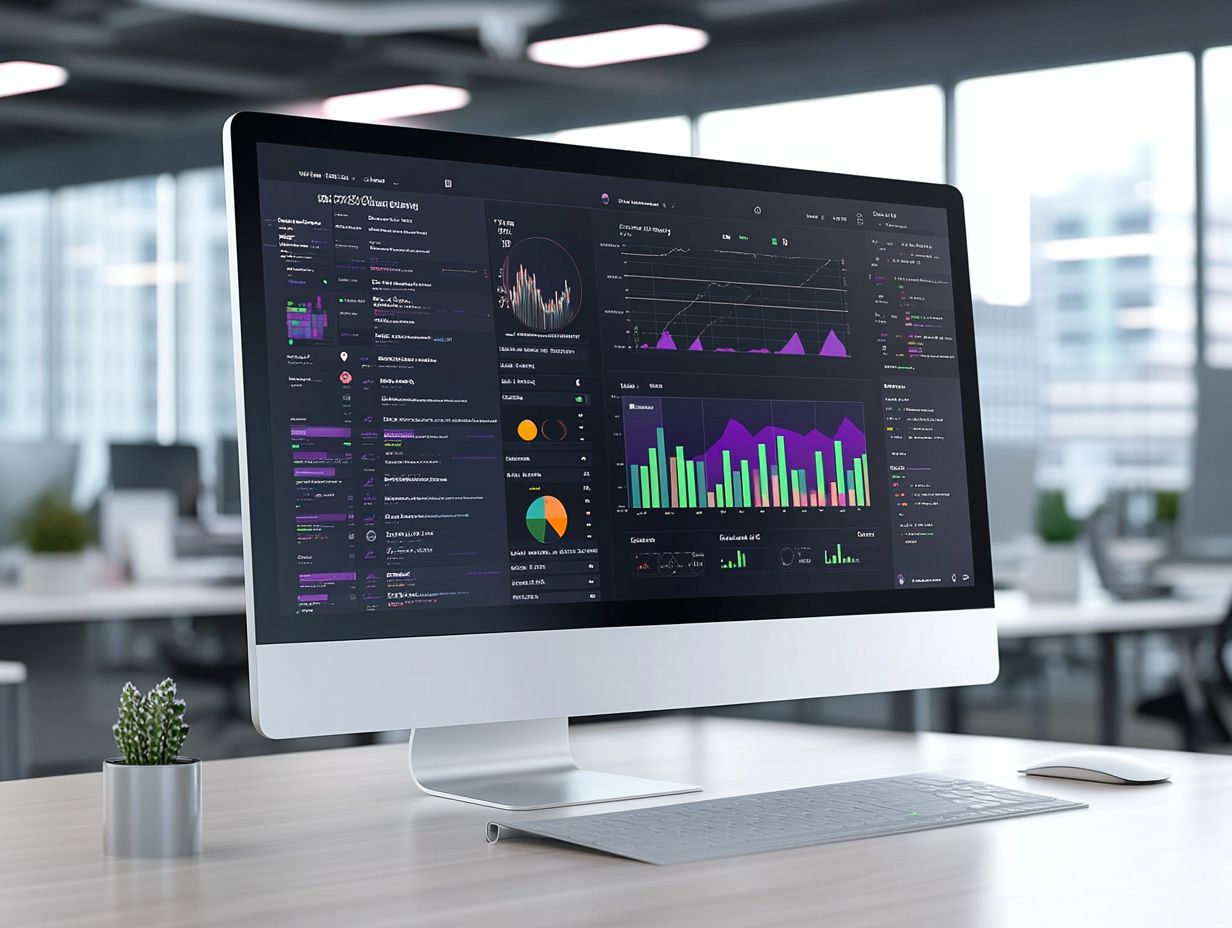
What are 5 IaaS Performance Monitoring Tools?
1) Nagios XI – Great for monitoring servers and networks effectively.
2) SolarWinds Orion – Offers customizable dashboards and predictive alerts.
3) Zabbix – A scalable, open-source tool with advanced monitoring capabilities.
4) Datadog – Provides a comprehensive view of infrastructure performance.
5) Dynatrace – An AI-powered tool offering insights into application performance.
What is Nagios XI?
Nagios XI is an IaaS performance monitoring tool that provides comprehensive monitoring and alerting capabilities for servers, applications, and network devices. It allows for real-time monitoring of infrastructure and provides detailed performance data and reports.
How does SolarWinds Orion help with IaaS performance monitoring?
SolarWinds Orion is a powerful IaaS performance monitoring tool that offers customizable dashboards, real-time performance metrics, and predictive alerts. It also has the ability to monitor and manage cloud-based resources, making it a great option for IaaS environments.
What makes Zabbix a popular choice for IaaS performance monitoring?
Zabbix is a highly scalable and open-source IaaS performance monitoring tool that offers advanced monitoring and alerting capabilities. It has a user-friendly interface and supports a wide range of operating systems, making it a popular choice for IaaS environments.
How does Datadog stand out among other IaaS performance monitoring tools?
Datadog is a cloud-based IaaS performance monitoring tool that provides a comprehensive view of infrastructure performance across servers, containers, databases, and more. It also offers integrations with popular cloud providers and automation tools, making it a popular choice for DevOps teams.
What Makes Dynatrace Stand Out in Performance Monitoring?
Dynatrace is an AI-powered IaaS performance monitoring tool that offers automatic discovery and mapping of infrastructure components. It provides detailed insights into application performance, user experience, and infrastructure utilization, making it a great choice for IaaS environments.
Try these tools today and transform your resource management!


